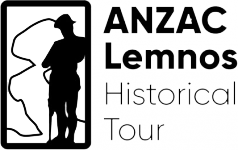
by anzac_admin | May 25, 2022
The Russian cemetery where refugees from Russia have been buried after the Bolsheviks prevailed in the Civil War of 1918-1920. They were White Russians, opponents of the Bolsheviks in the Civil War of 1917-1920. They were forced to leave Russia with Istanbul as their first stop. About 12,700 people, mostly Cossacks, men, women, and children, arrived in Lemnos from January to December 1920. They lived in tents in the former British and Australian camps. The latter left in November 1921 heading for Bulgaria and Serbia. A few dozen dead have been buried in the cemetery of East Mudros and the rest of them in the cemetery on the Portianou peninsula. This had been abandoned for many years and was rediscovered in 2004 by a Russian expedition.

by anzac_admin | May 25, 2022
The Supply Jetty Pier , which was mainly used to disembark camp supplies, was communicating by road with the Water Pier and the Turks Heads area. Most probably, it is the same road that is still used today.

by anzac_admin | May 25, 2022
The site of the Water Pier was named so because the barges used to load water there from the desalination plant and transport it to the Moudros Pier for the water supply of the camps and hospitals of the area.

by anzac_admin | May 25, 2022
The water desalination plant was created in the fall of 1915 and it was used to supply water to all the camps and hospitals in the area. It was powered by coal that was used to generate electricity, which was necessary to desalinate the water. The coal used to be unloaded at the Railway Pier and it was arriving by a short railway line without difficulty due to the smooth ground to the plant. The water was pumped into large reservoirs in the Turks Heads area for the water supply of the hospitals.

by anzac_admin | May 25, 2022
It was created in 1915 in order for the barges to unload coal and transport it by the railway line to the desalination plant. The decauville railway lines were built by Egyptian workers. However, it is not known whether the train was powered by a steam engine or a Hawthorn Leslie petrol engine like the short railway line at Mudros Pier.





